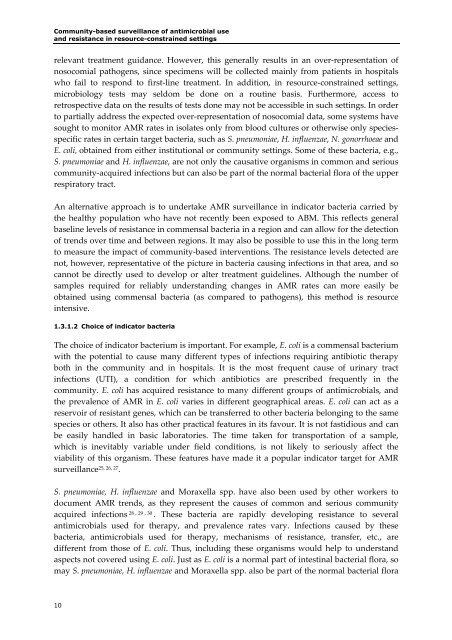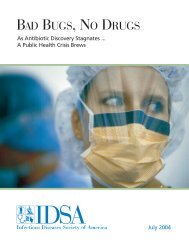Community-Based Surveillance of Antimicrobial Use and ...
Community-Based Surveillance of Antimicrobial Use and ...
Community-Based Surveillance of Antimicrobial Use and ...
- No tags were found...
You also want an ePaper? Increase the reach of your titles
YUMPU automatically turns print PDFs into web optimized ePapers that Google loves.
<strong>Community</strong>-based surveillance <strong>of</strong> antimicrobial use<strong>and</strong> resistance in resource-constrained settingsrelevant treatment guidance. However, this generally results in an over‐representation <strong>of</strong>nosocomial pathogens, since specimens will be collected mainly from patients in hospitalswho fail to respond to first‐line treatment. In addition, in resource‐constrained settings,microbiology tests may seldom be done on a routine basis. Furthermore, access toretrospective data on the results <strong>of</strong> tests done may not be accessible in such settings. In orderto partially address the expected over‐representation <strong>of</strong> nosocomial data, some systems havesought to monitor AMR rates in isolates only from blood cultures or otherwise only speciesspecificrates in certain target bacteria, such as S. pneumoniae, H. influenzae, N. gonorrhoeae <strong>and</strong>E. coli, obtained from either institutional or community settings. Some <strong>of</strong> these bacteria, e.g.,S. pneumoniae <strong>and</strong> H. influenzae, are not only the causative organisms in common <strong>and</strong> seriouscommunity‐acquired infections but can also be part <strong>of</strong> the normal bacterial flora <strong>of</strong> the upperrespiratory tract.An alternative approach is to undertake AMR surveillance in indicator bacteria carried bythe healthy population who have not recently been exposed to ABM. This reflects generalbaseline levels <strong>of</strong> resistance in commensal bacteria in a region <strong>and</strong> can allow for the detection<strong>of</strong> trends over time <strong>and</strong> between regions. It may also be possible to use this in the long termto measure the impact <strong>of</strong> community‐based interventions. The resistance levels detected arenot, however, representative <strong>of</strong> the picture in bacteria causing infections in that area, <strong>and</strong> socannot be directly used to develop or alter treatment guidelines. Although the number <strong>of</strong>samples required for reliably underst<strong>and</strong>ing changes in AMR rates can more easily beobtained using commensal bacteria (as compared to pathogens), this method is resourceintensive.1.3.1.2 Choice <strong>of</strong> indicator bacteriaThe choice <strong>of</strong> indicator bacterium is important. For example, E. coli is a commensal bacteriumwith the potential to cause many different types <strong>of</strong> infections requiring antibiotic therapyboth in the community <strong>and</strong> in hospitals. It is the most frequent cause <strong>of</strong> urinary tractinfections (UTI), a condition for which antibiotics are prescribed frequently in thecommunity. E. coli has acquired resistance to many different groups <strong>of</strong> antimicrobials, <strong>and</strong>the prevalence <strong>of</strong> AMR in E. coli varies in different geographical areas. E. coli can act as areservoir <strong>of</strong> resistant genes, which can be transferred to other bacteria belonging to the samespecies or others. It also has other practical features in its favour. It is not fastidious <strong>and</strong> canbe easily h<strong>and</strong>led in basic laboratories. The time taken for transportation <strong>of</strong> a sample,which is inevitably variable under field conditions, is not likely to seriously affect theviability <strong>of</strong> this organism. These features have made it a popular indicator target for AMRsurveillance 25, 26, 27 .S. pneumoniae, H. influenzae <strong>and</strong> Moraxella spp. have also been used by other workers todocument AMR trends, as they represent the causes <strong>of</strong> common <strong>and</strong> serious communityacquired infections 28,29,30 . These bacteria are rapidly developing resistance to severalantimicrobials used for therapy, <strong>and</strong> prevalence rates vary. Infections caused by thesebacteria, antimicrobials used for therapy, mechanisms <strong>of</strong> resistance, transfer, etc., aredifferent from those <strong>of</strong> E. coli. Thus, including these organisms would help to underst<strong>and</strong>aspects not covered using E. coli. Just as E. coli is a normal part <strong>of</strong> intestinal bacterial flora, somay S. pneumoniae, H. influenzae <strong>and</strong> Moraxella spp. also be part <strong>of</strong> the normal bacterial flora10




